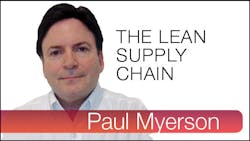Having had many years of experience in forecasting for companies such as Unilever and Arm & Hammer as well as consulting and training with many more organizations, I have come to appreciate the “art and science” of the forecasting process.
A new study by the Aberdeen Group “The Best-in-Class Leverage Forecast Accuracy Across the Organization”, documents that those companies that integrate demand planning as part of a larger Sales and Operations Planning (S&OP) process can get even more benefits than the 18% improved forecast accuracy at the product family level as documented in a previous survey.
For those of you not familiar with S&OP, it is a process that provides management the ability to strategically direct its business to achieve a competitive advantage on a continuous basis. The S&OP planning process includes an updated, collaborative forecast that leads to a sales plan, production plan, inventory plan, customer lead time (backlog) plan, new product development plan, strategic initiative plan and resulting financial plan. Ultimately, S&OP is a set of decision-making processes to balance demand and supply, to integrate financial planning and operational planning, and to link high-level strategic plans with day-to-day operations.
The added benefits beyond improved forecast accuracy keyed on the “Best-in-Class” companies’ ability to leverage that advantage all the way through their supply chain processes as well as the use of technology to ensure its success. The Aberdeen Group found the following Key Success Factors (KSF):
- Executive sponsorship is critical - the “Best in Class” are 25% were more likely to have it.
- Infrastructure in place – The most successful had a supporting cast framework for the demand planning process including dedicated S&OP support and best-in-class forecasting systems that integrate with their ERP systems.
- Collaboration and integration are critical – The “Best-in-Class” have master scheduling systems in place that are integrated with suppliers (and I would hope, their demand planning systems are integrated with customers as well!).
- Technological investments – Seen at all levels of the S&OP process including forecasting, scheduling and collaboration.
I think that this survey reinforces that in order to attain an overall competitive advantage (and to ensure Lean processes), it is important to not only have a solid forecasting process in place, but to have it integrated with the supply side through a solid S&OP process.
About the Author
Paul Myerson Blog
Professor of Practice in Supply Chain Management
Paul's blog "Lean Supply Chain," has moved. You'll find his latest ideas and commentary on IndustryWeek's IdeaXchange.
You'll find more articles written by Paul at http://www.industryweek.com/blog/lean-supply-chain.
Paul Myerson is Professor of Practice in Supply Chain Management at Lehigh University. He is the author of a Lean Supply Chain & Logistics Management (McGraw-Hill, 2012), developer of a Windows-based supply chain planning software (www.psiplanner.com), and co-author of a lean supply chain and logistics management simulation training game by ENNA (www.enna.com).
